Case Studies Eco-pond Systems for Wastewater Treatment and U
| 论文类型 | 技术与工程 | 发表日期 | 1999-09-01 |
| 来源 | 21th Century Urban Water Management in China | ||
| 作者 | Baozhen,WANG,Lin,WAN | ||
| 关键词 | Eco-pond systems Wastewater treatment and utilization Food chains Fish pond Aguatic plants pond | ||
| 摘要 | The principle, mechanism and theory on the performance of eco-pond systems are described in the paper in terms of removing various pollutants from wastewater to be treated by means of mass and energy transformation and transfer through food chains or web | ||
Case Studies Eco-pond Systems for Wastewater Treatment and Utilization in China
Baozhen WANG, Lin WANG and Luyu YANG*
Water Pollution Control Research Center
Harbin University of Architecture & Civil Engineering
* Department of urban Construction Ministry of construction
ABSTRACT
The principle, mechanism and theory on the performance of eco-pond systems are described in the paper in terms of removing various pollutants from wastewater to be treated by means of mass and energy transformation and transfer through food chains or web formed from fish farming and /or aquatic plants growing, which consist of decomposers like bacteria and fungi, producers like algae and other aquatic plants, and consumers at different trophic levels such as zooplankton, fish, duck and geese. Meanwhile, the organic and nutrient substances present in wastewater to be treated in the eco-pond systems are finally converted into fish, duck, geese and aquatic vegetable/plants as recovered resources.
Some case studies were carried out in this paper on eco-ponds projects for wastewater treatment and utilization, from which it has been realized that the eco-pond system is a low costs, energy saving and resource recoverable technology, which exhibits high removal efficiencies for various pollutants including organic substances, nutrients, heavy metals and bacteria, comparable to conventional or even advanced secondary treatment, while fish, duck/geese and/or aquatic vegetable or plants being recovered as valuable resources at much lower capital and O/M costs, only 1/3-1/2 and 1/5-1/3 that of a conventional secondary treatment plant of same capacity respectively.
Keywords: Eco-pond systems; Wastewater treatment and utilization; Food chains; Fish pond; Aguatic plants pond
1. INTRODUCTION
In order to effectively control the increasing water pollution in China mainly caused by discharge of increasing flow of municipal and industrial wastewater with rapid development of economy in recent years, China is now speeding up the construction and operation of more and more wastewater treatment plants, which employ various processes and systems according to the specific conditions of the cities and towns concerned respectively, of which as a general rule the conventional secondary treatment systems based on activated sludge process are mainly employed in municipalities and big cities, where the land available for the construction of wastewater treatment plants is limited and expensive; while in middle and small cities and towns the appropriate technologies are usually employed in their treatment plants due to the shortage of funds, energy and skilled operational personnel on one hand, and there existing more land area available to build such kinds of treatment plants at much lower capital and operation/maintenance costs compared with the conventional secondary treatment plants of the same capacity.
As exhibiting lots of advantages, such as low capital and O/M costs, energy saving, being easy to operate, stable in operational performance and the simultaneous realization of pollution elimination, resource recovery and water reuse from wastewater treatment, the appropriate wastewater treatment technologies have been developing rapidly in China, of which the eco-pond systems play the most important role.
The application of ponds to receiving and purifying sewage and manure from nearby villages and towns while culturing fish in east and south China has been a documentary verifiable practice with a long history of more than 2000 years. In villages in Pearl River Delta, for example, a large number of ponds have been used to receive not only human and animal manures, but also dung of silkworms, sugar cane leaves and grass, which can be used either to feed fish directly or as nutrient sources to promote the growth of algae and zooplankton for fish farming. On the basis of the above mentioned practice and experience, various field-pond systems such as mulberry field-pond, sugarcane field-pond and paddy field-pond have been developed there. The sludge removed from the bottom of ponds is usually applied to the subsoil of the field as organic fertilizer, thus forming various small ecological circulation systems.
Following up the tradition, China has now built more and more sewage and wastewater treatment ponds with eco-systems, which are different from those with symbiotic algae/bacterial systems that often result in high concentration of algae in effluents, thus causing secondary pollution to receiving waters. It is therefore necessary that this type of ponds are followed by algae removal facilities, such as micro-straining, flocculation/coagulation/settling, air flotation, rock or sand filtration units, which make the pond systems more complicated and expensive in construction, operation and maintenance, and consequently lose their inherent advantage, such as low costs, simplicity in construction and ease inoperation.[1-3]
2. PRINCIPLE OF ECO-POND SYSTEMS
The performance of the eco-pond systems is promoted by solar radiation as an initial energy source. Under the solar radiation, the anaerobic, facultative and aerobic bacteria and fungi present in the ponds degrade the organic pollutants contained in the influent (wastewater) into carbon dioxide, ammonia, nitrite, nitrate, phosphate, etc. as end products through various intermediate degradation steps. The algae and other aquatic plants, while capturing solar energy and taking up the inorganic degradation end products mentioned above as nutrients for their growth during photosynthesis, release molecular oxygen available for aerobic assimilation. In this way, a small portion (about 2-3 percent) of the total incident energy from solar radiation is converted into chemical form, i.e. chlorophyll and stored in aquatic plants for subsequent use by themselves and other organisms that consume them. The increased (surplus) micro-algae, bacteria and fungi serve as foodstuffs for zooplanktons, such as Paramecium, Colpidon, Amoeba, Rotaria, and Cladocera(Daphnia), which in turn serve as foodstuffs for shrimps, fish and duck. The small sized fish, shrimp, zooplankton and /or aquatic plants are consumed by duck and /or geese as available food stuffs for their growth. The snails, clams, shrimps and filter feeding fishes also consume micro-algae, thus preventing them from overgrowth and accumulation, and maintaining good quality of effluent with low SS concentration. The schematic diagram of an ecological system is shown in Figure 1.[3,4,5]
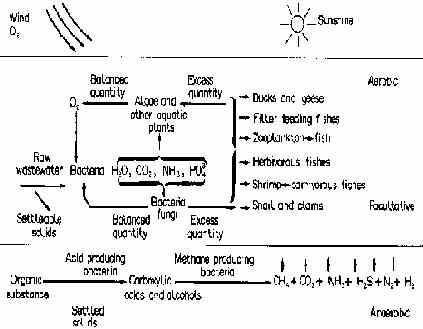
Figure 1 Schematic Diagram of Ecological System in Eco-ponds
The eco-ponds with the help of mass and energy transfer and transformation of substances present in wastewater through various food chains or webs consisting of producers (algae and other aquatic plants), decomposers (bacteria and fungi) and consumers as well as various physical and chemical processes taking place in ponds can effectively remove TSS, BOD, COD, bacteria, virus and mineral salts, while reclaiming them in forms of aquatic plants, fish, duck, and geese as recovered resources.
In addition to hundreds thousands of ponds in rural areas that receive, utilize and treat manure and sewage from their respective nearby villages and towns by means of fish farming, there are about several hundred municipal and industrial wastewater treatment and utilization ponds with eco-systems in operation in urban areas, which perform either solely or in combination with conventional treatment plants or irrigation farmlands.
3. CASE STUDIES ON TYPICAL ECO-POND SYSTEMS
The unit ponds applied for the treatment of sewage are classified anaerobic, facultative, aerobic, hydrophyte, fish, duck/geese and storage ones, from which various pond systems can be formed through different combination. Some typical eco-pond systems being used in China are described as follows:
3.1 Eco-pond systems available in northern arid areas
Sewage->preliminary treatment->facultative pond->storage ponds or lagoons (fish farming or duck geese raising in warm seasons)->irrigation on farmland->effluent;
High strength organic wastewater-> Preliminary treatment->Anaerobic ponds->Facultative ponds->Storage ponds or lagoons (fish farming and duck /geese raising in warm seasons) -> Farmland irrigation -> Effluent
3.2 Eco-pond systems available in Southern areas
Sewage or organic wastewater->Preliminary treatment-> Facultative ponds (with floating plants like water hyacinth growth)-> Fish farming ponds->Duck/geese ponds-> Lotus or reed ponds-> Effluent or
Sewage->Preliminary treatment->Facultative ponds (with water hyacinth growth)->Fish farming in paddy fields-> Effluent
Case 1-Eco-pond system in Qiqihaer City, Heilongjiang Province[6,8]
The Qiqihaer City, on the middle reach of Nenjiang River, is situated at 123o13‘ East Longitude and 47o52‘ Latitude and in the west of Heilongjiang Province. Being located in frigid temperature zone, it is characterized by continental monsoon climate with mean annual temperature of 3.2oC. About 150,000m3 of wastewater is treated in the lagoon daily. The layout of wastewater treatment and storage lagoon in Qiqihaer City is shown in Figure 2.
The incoming wastewater has been treated at high removal efficiencies for various pollutants (see Table 2). For instance, SS and BOD were removed greater than 90%; COD, synthetic detergent (DBS) and ammonia nitrogen, greater than 80%; lignin and zinc, greater than 95%; bacteria, greater than 99%; phenol and cyanide, some 90%; and so on.
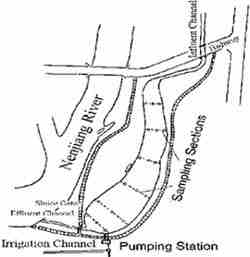
Figure 2 Layout of the wastewater treatment and storage lagoon in Qiqihaer City
Table2 The pollutant removal of the wastewater treatment and
storage lagoon in Qiqihaer City, Heilongjiang Province.

Case 2-Eco-Pond System in Anda City, Heilongjiang Province[6]
The pond system in the north of Anda City, which has north latitude of 46o0‘36‘‘ and east longitude of 126o52‘, was constructed in the frigid temperature zone accompanied with semi-arid continental monsoon. The winter season in Anda City lasts for more than 2 months with minimum temperature down to -40oC in general. Anda pond system is comprised of two parts, termed East Pond and West Pond (As shown in Figure 3), and both of which are in fan-shaped patterns. The design flow rates for the East and West pond are 3,000m3/d and 8,000m3/d respectively. Each unit of the two ponds is composed of sedimentation and water distribution well, anaerobic, facultative and aerobic or polishing/storage pond respectively; in one of the anaerobic ponds synthetic fibrous carriers were packed with a density of 2% to conduct a comparison test on the performance between the intensified pond and the ordinary one. The anaerobic ponds in East pond have hydraulic retention time of 3-4 days, a design depth of 4m and surface area of 1500 m2 for each anaerobic one including the area for water distribution well. The HRT for facultative pond is 9 days with a design water depth of 1.5-2.0m and a design volume capacity of 27,000m3 as well as a surface area of 16,000m2; the West pond has the volume capacity of 47,000m3 with HRT of 6 days, a design water depth of 2m (outlet part)-2.5m(inlet part) and a surface area of 20,000m2. The raw wastewater is mainly composed of dairy-producing, textile-manufacturing wastewater and domestic sewage. The performance of the Eco-pond system with removal efficiency for various pollutants is shown in Table 3. The removal efficiencies for various parameters are: COD 71.1%(cold period)-84.7%(warm period), BOD5 84.6-89.3%, TSS 84.2-83,6%, TKN 51,9-69.7%, TP 41.7-72.3%,Total coliform 99.7-99.99%.
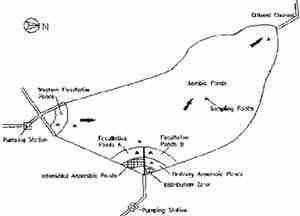
Figure3 Eco-pond treatment system in Anda City, Heilongjiang Province
Table 3 Removal Efficiency of Eco-pond system in Anda, Heilongjiang
Pond Unit COD BOD5 TSS TKN TP Total coli:formConc.
(mg/l)
Rem-oval
(%)
Conc.
(mg/l)
Rem-oval
(%)
Conc.
(mg/l)
Rem-
oval
(%)
Conc.
(mg/l)
Rem-oval
(%)
Conc.
(mg/l)
Rem-oval
(%)
cfu
Rem-oval
(%)
Season Influent Warm 313.1 163.2 282.5 18.5 3.5 6.7*107 cold 245.5 nbsp; 156.8 261.7 21.4 2.4 4.9*105
IAP(1)
Effluent Warm 171.9 45.1 92.1 43.5 105.1 62.8 14.3 22.7 2.4 31.4 2.1*105 68.7 cold 139.7 43.1 75.7 51.7 105.2 59.8 12.4 42.1 1.7 29.2 2.5*105 94.9
CAP(2)
Effluent Warm 180.8 42.3 98.2 39.8 117.7 58.3 14.5 21.6 92.5 28.6 1.7*105 74.6 cold 156.4 36.3 87.2 44.4 105.8 59.6 14.5 32.2 1.9 20.8 6.1*105 -24.5
FP-(3)
Effluent Warm 115.4 63.1 51.3 68.6 80.7 71.4 12.7 31.4 2.1 40.0 1.5*105 97.8 cold 103.4 57.9 50.8 67.6 78.7 69.9 13.1 38.8 1.7 29.2 7.9*105 83.9
FP-II(4)
Effluent Warm 115.8 63.0 57.1 65.0 88.5 68.7 13.1 29.2 2.1 40.0 1.3*105 98.1 cold 116.2 52.7 60.7 61.3 83.7 68.0 12.9 39.7 1.9 20.8 1.6*104 67.3
PP(5)
Effluent Warm 47.9 84.7 17.5 89.3 46.2 83.6 5.6 69.7 0.97 72.3 1*103 99.99 cold 71.0 71.1 24.1 84.6 41.3 84.2 10.3 51.9 1.4 41.7 1.4*104 99.7
Case 3- Eco-pond system in Wuhan City, Hubei Province[3,4,5]
The Eco-pond system is located on the middle reach of Yanze River, 18Km southwest of Ehcheng County, Hubei Province, and adjacent to the east surburb of Wuhan City, the Capital of Hubei Province. It is situated at 114o32‘ North Latitude, where the mean annual atmospheric temperature is 17oC,the mean annual sunshine time totaled 2085.4 hours with daily solar radiation rate of 47%.
The pond system was constructed by surrounding one of the Yarhu lakes called Yanjia Lake and divided into five cells in series with dikes and sluice gates as shown in Figure 4. The pond 1,2,3,4, and 5 have surface areas of 26.7, 23.3, 36.7, 100 and 213.3ha respectively, a total of 400ha with water depth of 3m for pond 1-4 and 1.5-2m for pond 5. The pond system was designed for the purpose of receiving and treating wastewater of some 80,000m3 per day from the chemical industrial zone of Wuhan City, with a retention time of 56 days. The raw mixed wastewater contains organic phosphorus insecticide, parathion, malathion, rogor, HCH, and nitrophenol as its main pollutants, of which the HCH, parathion and nitrophenol are most difficult to be degraded. The influent concentrations are COD 150 to 500(mean 276.3)mg/l, organic phosphorus 2-9 (4.3)mg/l, inorganic phosphorus 0.2-1 (0.58)mg/l, and p-nitrophenol 0.2-2.3 (1.07)mg/l.
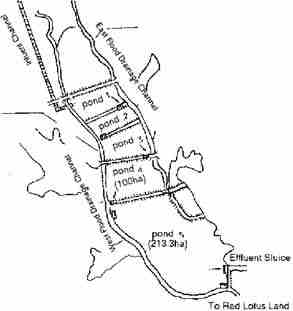
Figure 4 Layout of Yarhu Eco-ponds in Ehcheng County, Hubei Province
The five ponds have been operated in series as anaerobic/facultative pond, first stage facultative pond, second stage facultative pond, aerobic pond and fish farming pond respectively. In pond 5 fish have been raised in order to eliminate algae, aquatic plants and zooplankton growing during wastewater purification as their feeds, which has resulted in both bumper harvest of fish and further improvement of effluent quality. The growth and decay rules of several typical kinds of aquatic organisms in Yarhu Ponds are shown in Figure 5. The removal efficiencies for priority pollutants in the pond system during operation was shown in Table 4.
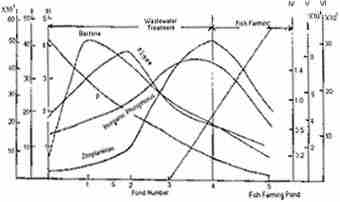
I. Bacteria, MPN/ml; II. P-Pollution index; III d-Species diversity index;IV. Inorganic phosphorus, mg/l; V. Algae, individuals per litre; VI. Zooplankton, individuals per litre.
Figure 5. The growth and decay curves
of several typical aquatic organisms in Yarhu ponds
Table 4 Removal efficiencies(%) for main pollutants in Yarhu Ponds
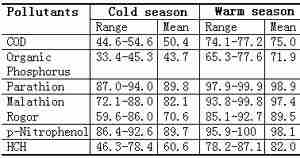
Case 4 Piggery Wastewater treatment and Fish Farming Pond System in Panyu city, Guangdong Province[7,8]
Jianfengshan Piggery produces 10,000 adult pigs annually and discharges 140m3/d wastewater a day. Considering that the annual average temperature in Pearl River Delta area is over 21oC and the annual sunshine time longer than 2,000 hours, the application of pond system for piggery wastewater treatment and utilization is available due to lots of advantages. This pond system consists of pretreatment facilities including two simple settling basins operating in parallel and two advanced anaerobic ponds (AAP) in parallel with fermentation pits in the front part of their bottoms, an anaerobic transformation pond packed with fibrous carriers for the attachment of submerged biofilm, aerobic pond consisting of five cells in series and equipped with one surface aerator in the first cell and a fish farming pond, which was originally a small reservoir with a total water surface area of 3 ha, and now receives the effluent from the aerobic pond and the abundant nutrients contained in it promote vigorous growth of phyto-plankton and zoo-plankton, which provides the raised fish including silver, big-head, grass, cruisian and ordinary carps with fish fry which grew very fast into adult fish of 1.2-1.5kg/unit fish just in 3-4months, and the annual fish production in 1993 was 6,500kg/ha. The layout of the pond system are shown Figure 6 and its operating results in Table 5.
The anaerobic transformation ponds (ATP) packed with fibrous carriers fixed on plastic circular plates made of hydrophillic synthetic material, the filling density was 28.3%. After one-month-operation, the biofilm got maturated with a full coverage of biofilm on the carriers and the biomass was measured to be 20g/l.

1. Inlet, 2. Fermentation pits, 3. Biofilm carrier, 4. Aerator (1.1kw), 5. Outlet
Figure6 Layout of Eco-pond system treating piggery wastewater in Jianfengshan Piggery, Panyu City, Guangdong Province
The algae/bacterial symbiotic pond (ABP) consisted of five cells in series, with 1.2m water depth in first two cells and 0.8m in last three cells, in which a large quantity of algae was produced through photosynthesis by using bacterial degradation products like CO2, NH4-N and PO4-P. As a result, the BOD5 was removed efficiently with an average removal of 72.5%. However, the TSS mainly consisting of algae increased significantly rather than decrease, which then moved to fish pond along with the effluent and served as foodstuffs of fish.
Table 5 Operational results of Eco-pond system in Jianfengshan Piggery, Panyu City
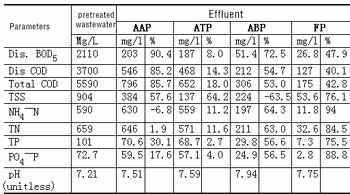
Case 5- Eco-pond system in Jiaozhou City, Shandong Province[6,8]

Screen 2. Pumping station 3. Primary settling basin packed with inclined plates
4.Flow rate measuring weir 5. Anaerobic pond 6. Multi-step water fall aeration weir
7. Facultative pond I 8. Facultative pond II 9. Facultative pond II
10. Polishing pond with fish forming and duck raising.
Figure 7 layout of Eco-pond system in Jiaozhou, shandong
Table 7 Removal efficiency of Eco-pond system in Jiaozhou, Shandong
Pond Unit COD BOD5 TSS TN TP Season Infl. Effl.R(%) Infl. Effl.
R(%) Infl. Effl.
R(%) Infl. Effl.
R(%) Infl. Effl.
R(%) Settling basin Warm 659.6 476.6 27.2 261.6 178.7 31.7 216.3 122 43.5 85.5 73.5 14 14 12.1 13.5 cold 742.5 328.1 55.8 237.6 120.9 47.4 184.3 91.6 46.4 122.8 80.5 34.4 15.6 10.5 32.5 Anaerobic
Pond Warm 476.6 255.3 46.4 178.7 68.6 68.4 122 49.7 59 73.5 66.6 9.4 12.1 11.8 2.4 cold 328.1 270.5 17.6 120.9 86.6 21.6 91.6 73.4 19.9 80.5 72.3 10.2 10.5 9.9 5.4 Facultative pond I Warm 255.3 179.5 29.6 42.1 38.6 38.6 49.7 69.8 - 66.6 37.9 43.1 11.8 8 32.2 cold 270.5 153.2 43.4 86.6 49 43.4 73.4 59.7 17 72.3 31.9 55.9 9.9 5.6 43.7 Facultative pond II Warm 179.5 167.2 7 42.1 42.1 - 69.8 57 20.1 37.9 12.2 67.8 8 3.05 61.8 cold 153.2 133.9 12.6 49 45.7 6.7 59.7 57.6 2 31.9 15.8 50.5 5.6 2.27 5.14 Warm 167.2 139.5 16.6 43.8 35.7 18 57 85.2 - 12.2 10.5 13.9 3.05 3.07 - cold
Table 6 Dimension of various unit ponds
Pond
Length
(m)
Width(m)
Water
depth (m)
Area(ha)
Volume
(104m3)
HRT
(d)
Anaerobic pond
534
360
3.6
18.0
64.8
22.0
Facultative pond I
507
360
2.2
18.25
40.15
13.4
Facultative pond II
360
294
2.0
10.58
20.16
6.7
Facultative pond III
360
294
1.3
10.58
13.75
4.6
Polishing/fish/duck pond
238
400
1.0
9.0
9
3.0
The performance of the pond system was investigated during 1992-1993, and the results are shown in Table7, which shows that various pollutants were removed effectively with removal efficiencies for COD 78.8%, BOD5 79%, SS 60.6%, TN 87.7% and TP 78.1%. The marked increase of suspended solids in facultative and fish/duck ponds is due to inadequate consumption of the increased algae by limited raised fish, which means that in order to control effluent SS as low as possible, say less than 30mg/l, more dense fish farming should be practiced with filtered feeding fish like silver and big-head carps as dominant species
Case 6 - Ecological Wastewater Treatment and Utilization System in Dongying City, Shandong Province[9]
Dongying City located at the Estuary of Yellow River, where exists the Shengli (Victory) Oil Filed, the second large Oil Field in China with an annual crude oil production of 32 million tons, is facing with an increasing acute water shortage because of the sharp decrease of flow in Yellow River with the zero flow period over 200 days in 1996 and 1997 respectively. As a result, a large area of the existing farmland has been abandoned due to water shortage for irrigation and aqua-culture.
Therefore, the municipal wastewater has to be reclaimed and reused as a regenerated or renovated water resource. The author and his colleagues at the invitation of the municipal government have been in charge of feasibility study and design of the municipal wastewater treatment plant. After many times field surveys, it is finally found that a multipurpose farm has been abandoned for several years because of no water flow from Yellow River, even though the hydraulic engineering facilities originally designed and constructed for use of Yellow River water are still in good condition. If the municipal wastewater is diverted into this farm, after proper treatment in the existing hydraulic engineering units like a reservoir with a storage capacity of 1.5millions of water and surface area of 36ha with modification into treatment units, such as advanced hybrid anaerobic ponds, aerated ponds and aerated fish ponds in series, the effluent will be good enough in quality and can be reclaimed and reused for fish farming, lotus, reed and rice growing.
With this concept, the author and his co-workers has designed the ecological wastewater utilization and reuse system (EWTUS) in this farm with the treatment and utilization flowchart as follows:

The layout of the EWTUS is shown in figure 8, and the design parameters of the unit ponds are shown in Table 8.
Table 8 Main design parameters of unit ponds of the Eco-pond system in Dongying
Unit pond

The predicated removal efficiencies for some main pollutants in various unit ponds are shown in Table 9, from which it is evident that the advanced anaerobic ponds will play a major role in organic removal with COD and BOD removal efficiencies of 53.3% and 57.1% respectively, which are much lower than those of the advanced anaerobic ponds treating high strength piggery wastewater as shown in Table 5 with COD and BOD removals of 85.7% and 90.4% respectively. The aerated ponds-aerated fish ponds that follow the advanced anaerobic ponds play very important role in removing organic pollutants with a final Effluent COD and BOD reaching 50 and 20 mg/l respectively.
The total capital cost of this project is 68 million Yuan (RMB), or US$ 8.2million,and the unit capital cost is 680Yuan or US$ 82; (m3/d), which is about one third that of conventional treatment plant employing activated sludge process.
The unit operation /maintenance (O/M) cost is only 0.1 Yuan/m3 or US$ 0.012/m3, in consideration of the significant income from fish farming. Lotus and reed planting, which could compensate most of the O/M cost. Pond Unit TSS BOD5 COD TKN TP coliform
Effl.
(mg/l)
Rem-
oval
(%)
Effl.
(mg/l)
Rem-
oval
(%)
Effl.
(mg/l)
Rem-
oval
(%)
Effl.
(mg/l)
Rem
-oval
(%)
Effl.
(mg/l)
Rem-oval
(%)
Effl.
MPN/L
Rem-
oval
(%) Influent 70 0 70 0 150 0 30 0 5 0 106 0 Pretreatment 65 7.0 65 7.0 140 6.6 30 0 5 0 106 0 Advanced anaerobic ponds 30 57.1 30 57.1 70 53.3 27 10 5 0 105 99 Aerated ponds 25 64.3 25 64.3 50 66.6 15 50 4 20 104 99.9 Aerated fishing pond 25 64.3 20 71.4 45 70.0 12 60 3 40 103 99.99 Fishing pond 25 64.3 15 78.6 40 73.3 10 66.6 2.5 50 102 99.99 Lotue pond 15 78.6 10 84.5 35 76.7 7 76.7 2 60 102 99.999 Reed pond 10 84.5 5 92.6 30 80 5 83.4 1.0 80 10 99.999
论文搜索
月热点论文
论文投稿
很多时候您的文章总是无缘变成铅字。研究做到关键时,试验有了起色时,是不是想和同行探讨一下,工作中有了心得,您是不是很想与人分享,那么不要只是默默工作了,写下来吧!投稿时,请以附件形式发至 paper@h2o-china.com ,请注明论文投稿。一旦采用,我们会为您增加100枚金币。








